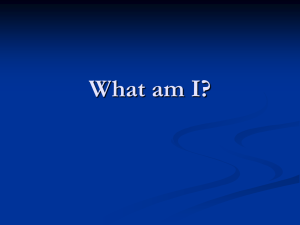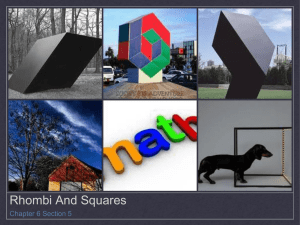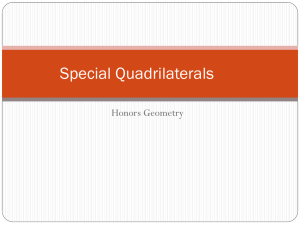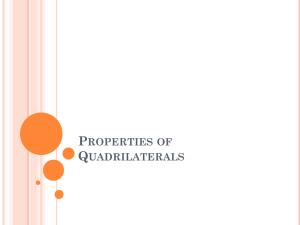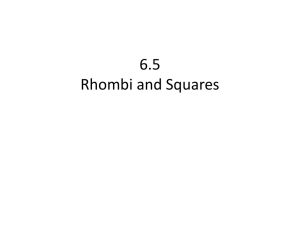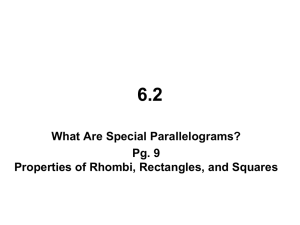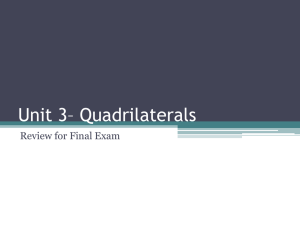6-5 Rhombi and Squares
advertisement
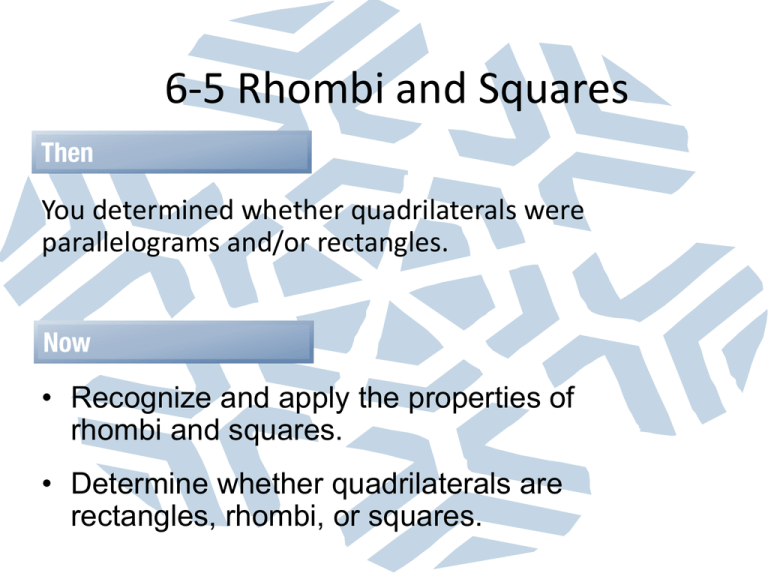
6-5 Rhombi and Squares You determined whether quadrilaterals were parallelograms and/or rectangles. • Recognize and apply the properties of rhombi and squares. • Determine whether quadrilaterals are rectangles, rhombi, or squares. Properties of a rhombus • A rhombus is a parallelogram with all four sides congruent. • A rhombus has all the properties of a parallelogram: Both pairs of opposite sides are parallel. Both pairs of opposite sides are congruent. Both pairs of opposite angles are congruent. The diagonals bisect each other. A pair of opposite sides are both parallel and congruent. AND….. Rhombus 1. Draw a rhombus on your paper. 2. Draw diagonals in your rhombus. 3. Measure the diagonals. Are the diagonals congruent? 4. Are the diagonals perpendicular? A parallelogram is a rhombus if and only if its diagonals are perpendicular. Page 430 A. The diagonals of rhombus WXYZ intersect at V. If mWZX = 39.5, find mZYX. Since WXYZ is a rhombus, diagonal ZX bisects WZY. Therefore, mWZY = 2mWZX. So, mWZY = 2(39.5) or 79. Since WXYZ is a rhombus, WZ║XY, and ZY is a transversal. mWZY + mZYX = 180 Consecutive Interior Angles Theorem 79 + mZYX = 180 Substitution mZYX = 101 Subtract 79 from both sides. Answer: mZYX = 101 B. ALGEBRA The diagonals of rhombus WXYZ intersect at V. If WX = 8x – 5 and WZ = 6x + 3, find x. WX WZ WX = WZ 8x – 5 = 6x + 3 2x – 5 = 3 2x = 8 x = 4 Answer: x=4 By definition, all sides of a rhombus are congruent. Definition of congruence Substitution Subtract 6x from each side. Add 5 to each side. Divide each side by 4. A. ABCD is a rhombus. Find mCDB if mABC = 126. A. mCDB = 126 B. mCDB = 63 C. mCDB = 54 D. mCDB = 27 Properties of Squares A square is a parallelogram with four congruent sides and four right angles. Square 1. Draw a square on your paper. 2. Draw diagonals in your square. 3. Measure the diagonals. Are the diagonals congruent? 4. Are the diagonals perpendicular? A parallelogram is a square if and only if its diagonals are perpendicular and congruent. This venn diagram summarizes the relationships among parallelograms, rhombi, rectangles, and squares. Page 431 Page 432 Write a paragraph proof. Given: LMNP is a parallelogram. 1 2 and 2 6 Prove: Proof: LMNP is a rhombus. Since it is given that LMNP is a parallelogram, LM║PN and 1 and 5 are alternate interior angles. Therefore, 1 5. It is also given that 1 2 and 2 6, so 1 6 by substitution and 5 6 by substitution. Answer: Therefore, LN bisects L and N. By Theorem 6.18, LMNP is a rhombus. Is there enough information given to prove that ABCD is a rhombus? Given: ABCD is a parallelogram. AD DC Prove: ADCD is a rhombus A. Yes, if one pair of consecutive sides of a parallelogram are congruent, the parallelogram is a rhombus. B. No, you need more information. Sachin has a shape he knows to be a parallelogram and all four sides are congruent. Which information does he need to know to determine whether it is also a square? A. The diagonal bisects a pair of opposite angles. B. The diagonals bisect each other. C. The diagonals are perpendicular. D. The diagonals are congruent. Recap… Rhombi: Squares: 4 rt ∠′ 𝑠 4 ≅ sides 4 ≅ sides 4 𝑟𝑡∠′ 𝑠 Opp sides ∥ Opp sides ≅ Opp∠′ 𝑠 ≅ Diag bisect other Opp sides ∥ Opp sides ≅ Opp∠′ 𝑠 ≅ Diag bisect other Opp sides ∥ Opp sides ≅ Opp∠′ 𝑠 ≅ Diag bisect other Diag ≅ Diag ⊥ Diag bisect opp∠′ 𝑠 Diag ⊥ & ≅ Parallelograms: Rectangles: Opp sides ∥ Opp sides ≅ Opp∠′ 𝑠 ≅ Diag bisect other 6.5 Assignment Page 435, 7-12, 23-33
